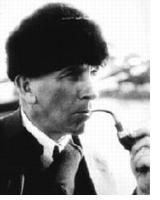Alfred Lothar Wegener
Meteorologist and geophysicist, b. 1 November 1880 (Berlin, Germany), d. November 1930 (Greenland).
 Alfed Wegener was the son of a Protestant pastor and orphanage director. The young Alfred showed an early love of the outdoors, which developed into strenuous physical activities such as hiking, mountain climbing and skiing. He also showed an interest in science and joined the University of Berlin in physics, meteorology and astronomy. He received his Ph.D. in astronomy in 1905.
Alfed Wegener was the son of a Protestant pastor and orphanage director. The young Alfred showed an early love of the outdoors, which developed into strenuous physical activities such as hiking, mountain climbing and skiing. He also showed an interest in science and joined the University of Berlin in physics, meteorology and astronomy. He received his Ph.D. in astronomy in 1905.
The Ph.D. thesis topic, the conversion of a set of 13th century tables from sexagesimal to decimal notation, was about as remote from Wegener's interest in physical exploits as imaginable and probably caused him to abandon astronomy in favour of meteorology. He joined the Prussian Aeronautical Observatory as a technical assistant, where he was assigned the task of atmospheric observations with instrumented kites and balloons. At one stage he undertook a 52.5 hour flight in a manned balloon himself, setting a record for free balloon flight.
In 1906 Wegener's fame as a physically fit and courageous scientist led to an invitation to join a Danish expedition to the Greenland ice cap as the expedition's meteorologist. On his return Wegener took up a teaching position at the Physical Institute of the University of Marburg and published a textbook on meteorology. He participated in another Greenland expedition in 1912 - 1913, wintering on the ice cap.
After military service in World War I Wegener joined the newly-founded University of Hamburg. Among his publications from the time is a paper on lunar craters, which he (correctly) described as impact craters, opposing the prevalent view that they were of volcanic origin.
In 1924 Wegener was appointed to the chair of meteorology at the University of Graz. In 1929 he went on another Greenland expedition. A fourth expedition to Greenland's ice cap in 1930 under his leadership was to become his last; he was caught in extreme weather and died on the way back to the base camp. He was buried by his Inuit (Eskimo) guide; his body was recovered the following spring.
Wegener's interest in geology arose in 1910 from reading a scientific paper about similarities between fossil bones in Africa and South America. Like others before he had noticed the similar shape of the African west coast and the American east coast. The find of similar bones sparked in him the idea that the continents could have moved apart through geological time. He began looking for other evidence; some of his activity during his Greenland expeditions were related to this idea.
The idea that the continents were once a single landmass - Wegener gave it the name Pangaea - had been promoted before, but geologists assumed that the separation had come about through the sinking of parts of the supercontinent. Wegener introduced the term Verschiebung der Kontinente (continental displacement) that later became "continental drift." He presented his theory in lectures from 1912 onward. Having been injured in battle during World War I he used the time in hospital to write Die Entstehung der Kontinente und Ozeane (The Origin of Continents and Oceans), which was published in 1915. He spent the rest of his life looking for more evidence of continental drift.
Wegener's theory found some adherents but was not widely accepted during his lifetime, and its author was criticized for straying from his area of expertise. One reason for the reserved reception of his ideas was that he could not offer a plausible forcing mechanism that could drive continental drift. At the time of his death continental drift had been discredited and fell into oblivion, until it was rediscovered thirty years later.
References
Golden, F. (1972) The moving continents. Charles Scribner's Sons, New York.
LeGrand, H. E. (1988) Drifting continents and shifting theories. Cambridge University Press, Cambridge.
home
 Alfed Wegener was the son of a Protestant pastor and orphanage director. The young Alfred showed an early love of the outdoors, which developed into strenuous physical activities such as hiking, mountain climbing and skiing. He also showed an interest in science and joined the University of Berlin in physics, meteorology and astronomy. He received his Ph.D. in astronomy in 1905.
Alfed Wegener was the son of a Protestant pastor and orphanage director. The young Alfred showed an early love of the outdoors, which developed into strenuous physical activities such as hiking, mountain climbing and skiing. He also showed an interest in science and joined the University of Berlin in physics, meteorology and astronomy. He received his Ph.D. in astronomy in 1905.